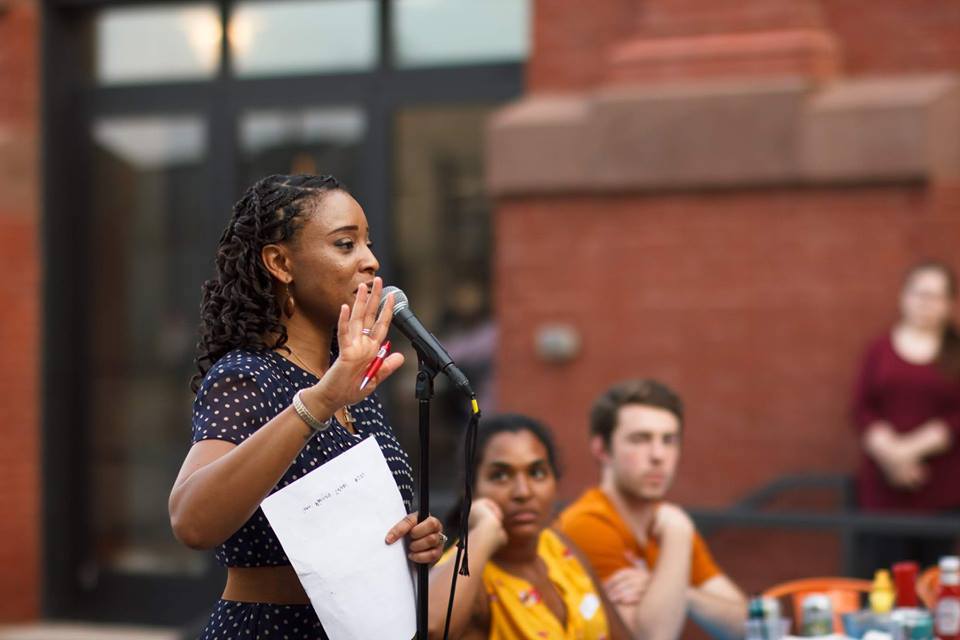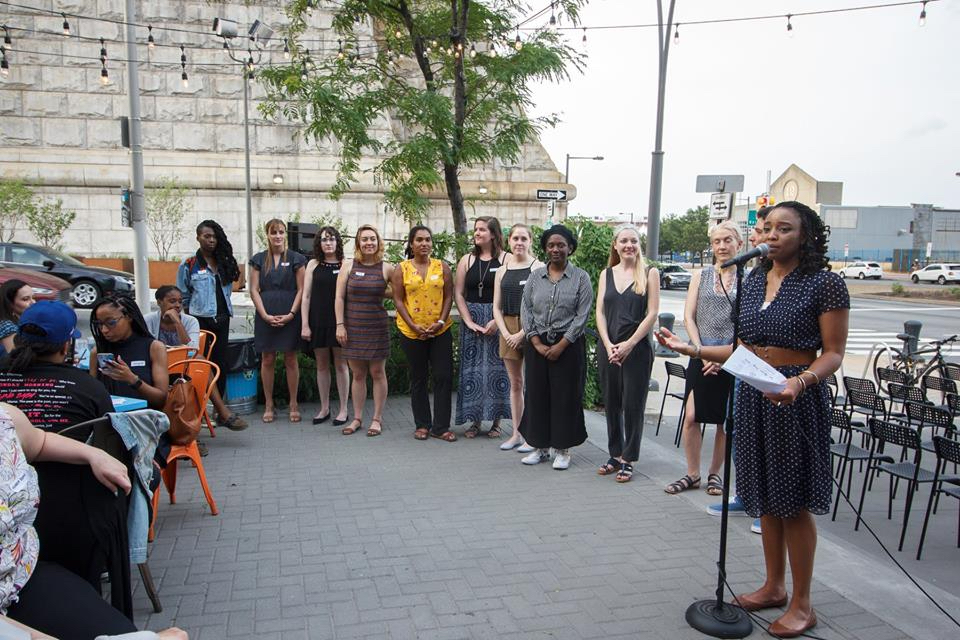Yes, micro-grants for artists do make a difference
 February 1, 2019
Category: Column, Featured, Funding, Long, Q&A
February 1, 2019
Category: Column, Featured, Funding, Long, Q&A
Cool Things Wit Cool People is a monthly column by Akeem Dixon focusing on community development. To ask a question, email coolthingswitcoolpeople@gmail.com, or reach out @akeemdixon.
When times get rough in the mythical, grimy city of Gotham, those in need make sure to shine the bat symbol high in the air to alert Batman of danger.
Transition cities, specifically those comprised primarily of people of color, have used art in a similar capacity. Artists of all kinds have seen their creations used to start the all-important gentrification and equity conversation.
Philly recently boasted a $19 million influx of capital thanks to a Knight in signing armor. Mural Arts is no longer in a monogamous relationship with the City of Brotherly Love. A local coffee chain is serving music and social justice alongside its cold brew and blueberry muffins.
Art is the ultimate olive branch as it rarely, if ever, has the opportunity to speak back. Its creators are typically the poorest while its supporters are often the richest and furthest removed from the social ills that inspired it.
Which leads to the questions: Where does this leave the artists, and who is supporting them and how?
Erica Hawthorne-Manon, the founder of Small But Mighty Arts, took off her cape long enough to explain how her organization provides services to artists of all kinds through cold hard capital, networking opportunities, advocacy and capacity-building resources.
###
Generocity: What is Small But Mighty Arts (SBMA)? Who started it? What does it do? Who does it do it for?
Erica Hawthorne-Manon: SBMA is a program that I started in 2012 after receiving a grant to develop a micro-grant project targeted to local artists. But the motivation for starting the program came from my experience as a working artist, and considering the need for artists to have greater access to tools and resources that provide a pathway for building capacity, and persisting in the pursuit of our creative work.
I was adamant about not wanting me or my peers to fall into the stereotypical “starving artist” category. We were hard-working, inventive and entrepreneur-minded creatives with a desire to continue to develop our skills and creative work. I started SBMA by asking other local artists what resources were critical for their creative development and persistence.
Among the top three resources was funding, hence the initial creation of our micro-grant program, but what was more evident in artists’ feedback was their interest in capacity-building resources, professional development and building their networks. That moved me to enrich SBMA’s engagement and focus.
Through SBMA’s projects, we work to connect artists to career-enhancing resources via micro-grants, connections to paid opportunities through our partnerships, and programs that facilitate community-building and professional networking. We engage more than 2,000 local creatives through our programs, events and online platforms, and these artist represent 40+ artistic disciplines and at least 49 ZIP code areas throughout Greater Philadelphia and Southern New Jersey.
Generocity: Micro-grants have been one of SBMA’s most well-known programs. Why have you been a fan of micro-grants?
EHW: In our early surveys of artists, 85 percent reported that they rely primarily on their own resources in order to pursue their creative work. Additionally, 73 percent reported that they would not be able to continue their creative work without timely and adequate funding. In Philadelphia, we are surrounded by a rich, active creative scene, so we may take for granted that in order for this wonderful landscape to exist, there are hundreds of creatives at its root that are working to maintain and secure foundational tools and resources in order to present their work.
Micro-grants are an investment, and a means to increase persistence among artists — in the development of their work and their ability to secure additional resources. It is a method to stimulate the local creative economy by investing in its producers and workforce so they continue to participate in the creative ecosystem.
SBMA micro-grants are designed to consider the various uses of funding among artists and support them based on what they have expressed as the need and importance for all levels of their creative process. To acknowledge this, SBMA micro-grants provide artists with funds for works-in-progress, completion of work, physical resources and professional development.
Intrinsically, micro-grants provide a “spark” for artists, igniting a sense of purpose, confidence, and access. We know Philadelphia’s artists are resourceful, determined and yes, extremely talented. But in addition to the living expenses that we must take care of, artists have the additional lift of bearing the costs of crafting and presenting their work. I don’t think we’ve considered seriously enough what it means that the creators, curators and workforce of the creative economy often struggle to make an adequate living.
Generocity: How do you think micro-grants can be used by large foundations to impact the arts and community development?
EHW: When other industries are faced with such a challenge among their workforce, it is seen as imperative to examine and take action to ensure that they can advance and thrive. SBMA, along with local organizations like the Leeway Foundation, the Vision-Driven Artist Series, the Corzo Center, ArtistU, InLiquid and community organizations like the Village of Arts & Humanities have provided local artists with critical support, not only to advance their creative work, but to develop their professional capacity.
I think major institutions (funders, institutions of higher education, local government) can make an impact by investing in existing artist-supporting organizations so they can continue to develop and deliver capacity-building programs and outreach. Performance and project support is necessary, but support for career-building, professional development, training and pipeline development is significantly imperative.
Through SBMA’s partnerships with larger or more established organizations such as the Bartol Foundation, FringeArts and Cee Smith Media, we were able to collectively expand micro-funding to artists as well as expand their capacity and opportunities for professional development. Through partnerships I see the opportunity to make a significant shift — to engage larger institutions in partnership toward developing successful initiatives, and not just as a funder-grantee or organization-curator interaction.
By establishing models of partnership based on shared values and equitable investment, there is an opportunity to build a more balanced ecosystem that has greater returns for the whole of the ecosystem, and especially to those we aim to support.
Generocity: Detail some of SBMA’s success stories?
EHW: SBMA has provided more than 50 artists with micro-funding and secured paid opportunities to dozens of artists. SBMA has also distributed resource information to hundreds of artists throughout Greater Philadelphia. Though the collective number of artists we’ve engaged is significant, it does not outweigh our value of each individual artist we have the privilege to connect, and the ways we learn how we can continue to be purposeful and equitable in our support of artists.
Our greatest success is palpable when we are able to provide essential support to an artist, and re-invest in their persistence by connecting them to other opportunities in our network and through our additional programs. It justifies what we do when we see those artists continue to make significant creative and professional progress and expand their networks.
- SBMA-supported artist Ani Gavino was awarded a micro-grant to produce an original work “Herstory” in the 2017 Fringe Festival. The work was commissioned soon after for a performance with a Denver repertory dance company and locally at the Barnes Foundation.
- In 2016, SBMA awarded filmmaker Tayarisha Poe with micro-funding for much needed pre-production costs for a work-in-progress, which Tayarisha shared was “indeed small but mighty” as it allowed her and her team to continue to work through the summer, and cover travel to meet with key stakeholders. The film project, “Selah and the Spades,” will see the light of day as a featured film at the 2019 Sundance Film Festival.
- Most of our micro-grant success stories come from artists’ feedback of how our grant came at just the right time, or covered an expense they otherwise did not have the means to cover. This year, thanks to really supportive partners and funders, SBMA awarded 29 artists funding to present Fringe Festival performances, curate community performances, complete teaching artist projects and expand their creative businesses through training courses, staffing, equipment purchases and other foundational resources.
Over the years, we’ve also had wonderful project partnerships that have resulted in paid opportunities, greater exposure and network-building among our supported artists.
One of the first was our work with The Enterprise Center to secure local artists for the Meter Mural Project along the 52nd Street Business Corridor. Visual artist Monna Morton participated in the project and we were able to connect her to our partnership project with the Office of Arts & Culture for the Philadelphia International Unity Cup Banner Project in which she received a Graphic Design USA award for her work.
For four years, we have partnered with the Barnes Foundation as a community and program partner. Through this partnership, SBMA has presented more than 40 SBMA-supported artists at the Barnes’ Artist Bash event and annually at PECO Family Sunday each November.
What I love about our partner programs is it gives us an opportunity to connect artists who may be emerging artists, or new to a partner or community, and bring awareness and engagement between the artist, their work and the community.
Generocity: Research from the National Endowment for the Arts found that women visual artists make 81 cents to every dollar by their male counterparts. And a report from a City University of New York arts course found that women artists of color, in particular, were heavily underrepresented in New York galleries.
Given that, can you discuss any challenges that you face as a person of color navigating the art and philanthropic world, maybe centered around race, policy, professional development or mentorship?
EHW: I’ve been fortunate to have a network and community of artists, colleagues, partners, donors and family that have been catalysts, connectors and active supporters. Even so, I’ve faced challenges related to access to resources, professional development and pipelines that foster opportunities to advance my existing work.
There is research that supports the importance of support for leaders of color, but the common result is investments in board leadership, traditional organizational structures or participation in already established initiatives. While this is important — especially when developing impactful partnerships and networks — there is also a need for capacity-building support for organizational leaders of color who have created problem-solving initiatives, and who are most often closely connected to the communities they serve.
This includes access to tools and opportunities that enhances the capacity of our work, and takes into account the particular approaches we have demonstrated as most effective and impactful, even if that looks different than the norm, and especially if it succeeds in having a positive impact on the communities we serve and ensures our persistence.
###
It’s a marvel how a mural on the side of the right building or a themed public space activation with the right marketing can change the perception of a community. If a picture is worth a thousand words, then what is the true value of an art installation or vacant lot revamp?
The tragic conditions in too many communities have morphed artists of all kinds into gentrification first responders. When using their creative genius for good, they are able to capture the communities history and magnify the voice of residents. Just like a piece of art, the amount of support artists and organizations such has SBMA received from large institutions and city government has been subjective.
Strategic initiatives that empower organizations such as SBMA that manage the needs of artists while helping them achieve sustainability would assuredly be viewed as a work of art.
Project
Cool Things Wit Cool PeopleTrending News











